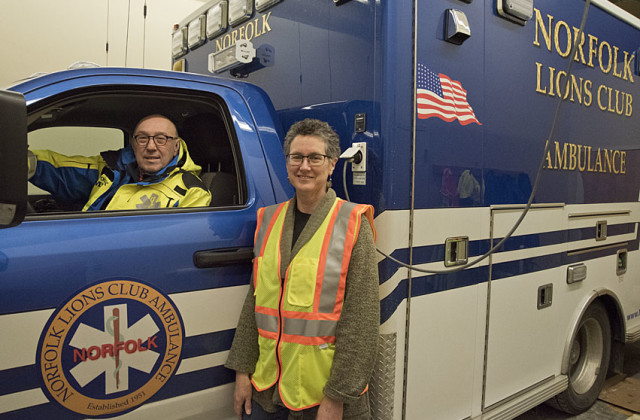Fresh Crop of EMR’s Joins Norfolk Ambulance
By Wiley Wood
The sign next to the ambulance building on Route 44 reads “Volunteers Needed.” And this winter, the Norfolk Lions Club Ambulance got a fresh influx of volunteers. Eleven people took the latest Emergency Medical Responder’s course, and seven of the newly minted EMR’s are expected to join the ambulance, according to Chief Christopher Little, who is also welcoming four new drivers to the rotation.
“This is colossal,” said Little. “It’s a huge thing for us, a big infusion of talent.”
The corps responds to calls around the clock, every day, with a primary responsibility for Norfolk and half of Colebrook. On each call, the ambulance is staffed by at least three people: a driver, an Emergency Medical Technician (more highly qualified that an EMR), and an EMR or a second EMT. The ambulance fields about 250 calls a year.
State certification as an EMR requires 80 hours of classroom instruction, followed by a practical and a written test. New EMR’s also spend 10 hours shadowing a medical technician in the Emergency Department of one of the area hospitals and ride along on ambulance calls as observers before becoming full members of the crew.
“I was a little worried about being older and in school again,” says Barbara Spiegel, one of the new EMR’s, “but I feel I learned a lot that I didn’t know.” Recently retired, she describes the ambulance corps’ activities as very different from her work, which was an attraction for her.
John Fernandez, another new EMR, praised the course and its instructor, Kitty Hickox. Classes started around Christmas and continued through the first half of February, with meetings on Tuesdays and Thursdays from 6:30 to 10 p.m. The levels of interest and participation were high. “I felt very fortunate in the classroom dynamic,” said Fernandez.
The EMR learns protocols for approaching a patient. “If you’re first on the scene, you’re trained to make sure the scene is safe, then get an initial impression of the patient—are they alert, responsive. I’ll administer oxygen if needed, ask questions to assess the severity of the complaint, take vital signs, get a list of medications, and assist when someone more experienced shows up,” said John Fernandez.
The EMR learns to administer CPR, use a defibrillator, give oxygen. “Basically, it makes you better informed to assist an EMT or a paramedic, but you haven’t really learned enough to be fully in charge,” said Fernandez, who is considering volunteering for the Winsted ambulance, which has a higher call volume, and certifying as an EMT, so that he can work shifts at a local hospital.
The other members of the recent EMR course are Toby Young, Michael Halloran, Peter Anstey, David Kritchman, Sam Hester, Karijelin Hester, Maria Hester, Aileen Hester, and John Hester.
The cost of the course is $325 per person, but for the first time Norfolk Ambulance paid the cost up front. Little reports that there has been sufficient interest for a new EMR course to be offered this spring.
Photo by Bruce Frisch.

